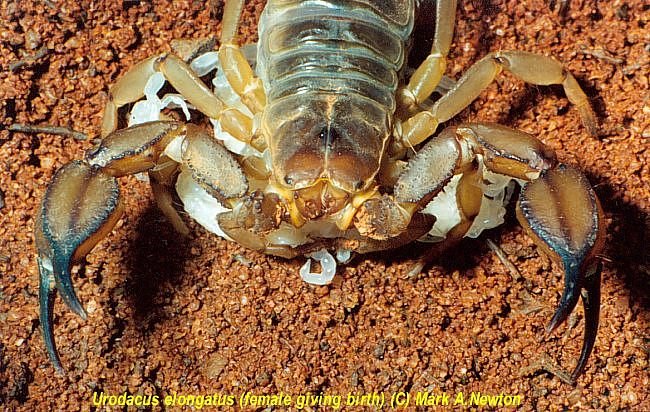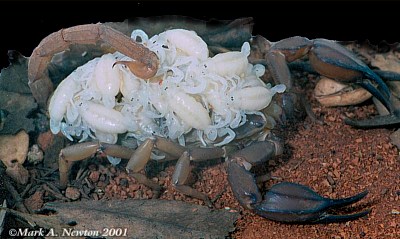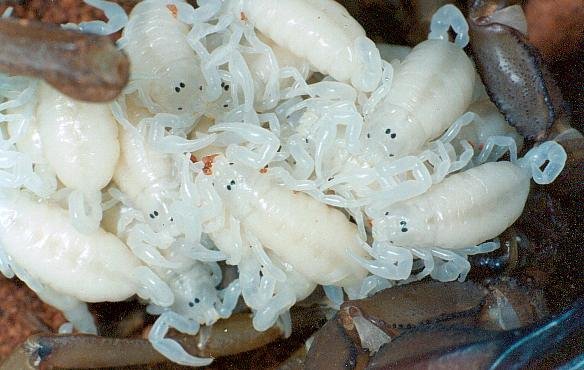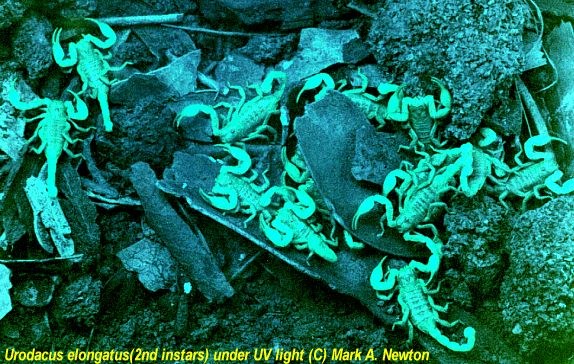
-Features-
Female Reproductive System & Live Birthing.
Female Reproductive System The inner wall of the ovariuterus has a germinal epithelium layer that gives rise to the oocytes. Oocytes grow outward from the ovariuterus, and in the early stages are not apparent. As development continues the oocyte appears as an outward bulge of the ovariuterus, surrounded by trophic follicle cells. The enlarging oocyte remains as a protuberance of the outer ovariuterine wall, whilst maintaining an opening to the lumen of the ovariuterus, presumably to allow passage and uptake of sperm. From this point on there are two major forms of further development in scorpions. In one group of scorpions the fertilised ovum passes back into the lumen of the ovariuterus where it continues and completes development right up to parturition. Families showing this development are the Buthidae, Bothriuridae, Chactidae, Iuridae and Vaejovidae. Cells in the ovariuterine wall transfer nutrients into the lumen where they are absorbed by the integument of the embryo. This form of development was termed by Laurie (1886) as "apoikogenic", meaning "away from home", in consideration of the change from early development. In the families, Diplocentridae, Ischnuridae, Scorpionidae and Urodacidae the fertilised ovum remains within the protuberance of the ovariuterine wall, which becomes known as a diverticulum. As the embryo develops and increases in size a specialised feeding structure forms that transfers nutrients from the maternal haemolymph to the mouth of the developing embryo. This type of development was termed by Laurie (1896) as "katoikogenic", meaning, "at home". Apoikogenic development is thought to be primitive due to it's close similarity to the development characteristics of ancestral aquatic chelicerates and is less complex than that of the katoikogenic plan. The katoikogenic plan shows similarities with other primitive chelicerates, but also shows specialised ovariuterine structures (diverticulum, appendix). In addition to this the anterior appendages, mouth, and digestive tract differentiate early, enabling the embryos to ingest maternal nutrients. This is in contrast to apoikogenic development where mouth and digestive tract develop late, suggesting absorption of nutrients by surrounding membranes and embryonic integument in early embryos.
Gestation and Parturition Temperate species often show synchrony with birthing, even in species where mating is not synchronised. Because scorpions are ectotherms, embryonic development is arrested during cold periods and accelerated with the onset of warm weather. In Australia the Urodacus genus often mate in spring and have their young at the end of the next summer, i.e., approximately 18 months gestation. It would appear as though development during the first warm period after mating is not long enough to complete embryonic development. Urodacus elongatus kept in captivity (personal observation), allowed to mate artificially early in very early spring have shortened gestation periods, giving birth by the end of the following summer. This 8-month gestation period is a reflection of the artificially high temperatures of captive conditions and the early mating, allowing full development in a shorter period of time to that observed in the wild. Although this period is probably borderline as only one out of three pregnant females had young which survived after birth. Parturition in Urodacus elongatus (personal observation) is most likely triggered by environmental factors such as dropping temperatures and increasing humidity. This observation came about by synchronised birthing at a point in time when temperatures were dropping and humidity was on the increase, due to comparatively warm days and cold mornings. This captive observation correlates with that seen in the wild, where many juvenile scorpions are first seen in autumn.  Just before birthing begins the female scorpion assumes the birthing position, whereby she arches her body off the ground and forms the birth basket with her front two pairs of legs. One scorpion is born at a time and gradually they accumulate under her body (see picture above). As the bundle of young accumulates some begin to make their way onto their mothers back. Parturition was observed to be complete after about two hours in Urodacus elongatus, with all the young making their way to mothers back in two more hours.

 Once young leave the mother (post first moult), they do not return to her and continue their own independent existence. 
|